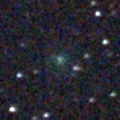
|
Now it is very bright as 11.2 mag (May 31, Chris Wyatt). It brightened very rapidly when it was not observable near by Sun. In the Southern Hemisphere, it stays observable in the evening sky for a long time after this while the comet will be fading. It is not observable at all in the Northern Hemisphere.
Date(TT) R.A. (2000) Decl. Delta r Elong. m1 Best Time(A, h)
June 1 5 24.69 -28 13.5 1.769 1.390 51 11.5 18:26 ( 69, 20)
June 8 5 53.68 -30 55.1 1.724 1.414 55 11.7 18:25 ( 67, 22)
|
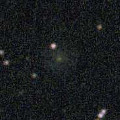
|
Now it is very bright as 11.5 mag (May 24, Michael Jager). It brightens up to 11.5 mag from May to June. However, it locates very low in the Northern Hemisphere. It is not observable in the Southern Hemisphere.
Date(TT) R.A. (2000) Decl. Delta r Elong. m1 Best Time(A, h)
June 1 4 51.59 59 40.0 1.935 1.294 37 11.6 18:26 (144,-31)
June 8 5 49.19 57 47.1 1.965 1.291 36 11.6 18:25 (144,-26)
|
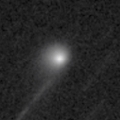
|
Appearing in the morning sky in the Southern Hemisphere. It will appear in the morning sky in late June in the Northern Hemisphere. It will brighten up to 10.5 mag and it will be observable in good condition from autumn to winter.
Date(TT) R.A. (2000) Decl. Delta r Elong. m1 Best Time(A, h)
June 1 2 16.87 2 1.5 4.231 3.497 38 12.6 5:29 (252, 20)
June 8 2 21.36 3 28.2 4.134 3.468 43 12.5 5:32 (246, 25)
|

|
Now it is not observable. It will appear in the morning sky again at 13-14 mag in August.
Date(TT) R.A. (2000) Decl. Delta r Elong. m1 Best Time(A, h)
June 1 4 27.46 19 11.1 3.083 2.072 3 12.8 5:29 (257,-15)
June 8 4 44.47 19 35.8 3.094 2.086 5 12.8 5:32 (255,-13)
|

|
It brightened up to 7.7 mag in June in 2018 (June 19, Juan Jose Gonzalez). Now it is fading. But it is still bright as 13.4 mag (May 30, Chris Wyatt). In the Southern Hemisphere, it stays observable for a long time until the comet will fade out. In the Northern Hemisphere, it is not observable for a long time until autumn when the comet fades out down to 16 mag.
Date(TT) R.A. (2000) Decl. Delta r Elong. m1 Best Time(A, h)
June 1 5 45.61 -32 50.5 4.336 3.886 57 13.3 18:26 ( 67, 26)
June 8 5 53.19 -31 49.6 4.420 3.943 55 13.4 18:25 ( 66, 22)
|
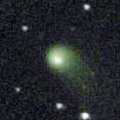
|
Now it is 13.5 mag (May 30, Chris Wyatt). It stays 13-14 mag until summer. It is observable in excellent condition in the Southern Hemisphere. In the Northern Hemisphere, it will be getting lower gradually, and it will be unobservable in July.
Date(TT) R.A. (2000) Decl. Delta r Elong. m1 Best Time(A, h)
June 1 15 9.46 -42 34.2 2.557 3.491 152 13.5 22:30 ( 0, 82)
June 8 14 51.21 -42 59.4 2.626 3.515 146 13.6 21:44 ( 0, 82)
|
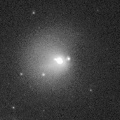
|
Appearing in the morning sky. Now it is bright as 13.7 mag (May 8, Chris Wyatt).
Date(TT) R.A. (2000) Decl. Delta r Elong. m1 Best Time(A, h)
June 1 0 42.06 12 4.6 6.276 5.768 55 13.7 5:29 (226, 30)
June 8 0 45.74 12 37.5 6.184 5.768 61 13.7 5:32 (219, 33)
|
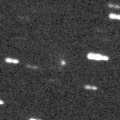
|
Now it is bright as 13.2 mag (May 30, Thomas Lehmann). It stays 13 mag for a long time in 2019. In the Southern Hemisphere, it is observable in excellent condition. In the Northern Hemisphere, it is not observasble until summer in 2020.
Date(TT) R.A. (2000) Decl. Delta r Elong. m1 Best Time(A, h)
June 1 7 27.27 -52 14.1 2.989 3.042 83 13.8 18:26 ( 48, 48)
June 8 7 30.26 -52 8.9 3.012 3.035 81 13.8 18:25 ( 48, 45)
|
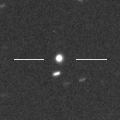
|
It is expected to brighten up to 7 mag in 2020. Now it is not observable. It will appear in the morning sky in July.
Date(TT) R.A. (2000) Decl. Delta r Elong. m1 Best Time(A, h)
June 1 3 59.56 12 33.3 5.292 4.307 12 14.1 5:29 (259, -6)
June 8 4 5.65 13 18.7 5.206 4.242 16 14.0 5:32 (255, -2)
|

|
It approached to Earth down to 0.3 a.u. in mid February, and brightened up to 5.5 mag (Feb. 13, Juan Jose Gonzalez). Now it is fading. It has already faded down to 13.0 mag (Apr. 24, M. Lehky). Now it is not observable. It will appear in the morning sky in July in the Northern Hemisphere, or in August in the Southern Hemisphere.
Date(TT) R.A. (2000) Decl. Delta r Elong. m1 Best Time(A, h)
June 1 4 36.62 34 53.4 3.052 2.077 12 14.2 18:26 (117,-24)
June 8 4 38.89 35 15.2 3.123 2.149 13 14.5 5:32 (240,-20)
|
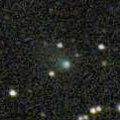
|
It is expected to brighten up to 10 mag in autumn. Now it is 13.4 mag (May 22, Thomas Lehmann). In the Northern Hemisphere, it stays observable for a long time while the comet is brightening. In the Southern Hemisphere, it it not observable until mid September.
Date(TT) R.A. (2000) Decl. Delta r Elong. m1 Best Time(A, h)
June 1 4 7.33 64 25.8 2.599 1.977 42 14.5 5:29 (210,-32)
June 8 4 13.07 63 26.9 2.554 1.916 41 14.4 5:32 (210,-29)
|
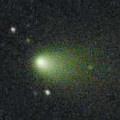
|
It brightened up to 12-13 mag from winter to spring. Now it is fading. It has already faded down to 14.5 mag (May 23, Katsumi Yoshimoto). It is observable in excellent condition in the Northern Hemisphere. It locates somewhat low in the Southern Hemisphere.
Date(TT) R.A. (2000) Decl. Delta r Elong. m1 Best Time(A, h)
June 1 11 25.53 14 54.8 1.970 2.310 96 14.7 18:48 (180, 40)
June 8 11 32.63 13 6.9 2.067 2.331 91 14.9 18:28 (180, 42)
|

|
Now it is 14.4 mag (May 8, Chris Wyatt). In the Southern Hemisphere, it is observable for a long time. In the Northern Hemisphere, it will never be observable again.
Date(TT) R.A. (2000) Decl. Delta r Elong. m1 Best Time(A, h)
June 1 0 20.62 -45 11.3 3.955 4.054 88 14.8 5:29 (302, 62)
June 8 0 24.42 -45 0.9 3.896 4.069 92 14.7 5:32 (304, 67)
|
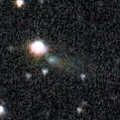
|
Now it is 14.8 mag (May 10, Katsumi Yoshimoto). It brightens up to 15 mag from May to June, and it will be observable in good condition.
Date(TT) R.A. (2000) Decl. Delta r Elong. m1 Best Time(A, h)
June 1 23 0.40 31 46.4 1.567 1.601 73 15.0 5:29 (193, 22)
June 8 23 18.29 34 28.2 1.569 1.620 74 15.1 5:32 (189, 20)
|
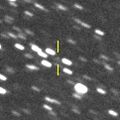
|
Now it is 16.4 mag (May 2, Toshihiko Ikemura, Hirohisa Sato). It will brighten rapidly after this. It will be observable at 13.5 mag in good condition in autumn.
Date(TT) R.A. (2000) Decl. Delta r Elong. m1 Best Time(A, h)
June 1 17 44.76 -4 41.4 1.429 2.389 155 15.6 1:10 (180, 60)
June 8 17 40.68 -4 7.7 1.371 2.347 159 15.4 0:38 (180, 59)
|
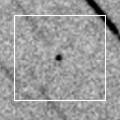
|
It passes the perihelion on July 2. Then it brightens up to 13 mag, but it is not observable around that time. In the Northern Hemisphere, it will appear in the morning sky at 16 mag in late July. In the Southern Hemisphere, it will be too low to observe.
Date(TT) R.A. (2000) Decl. Delta r Elong. m1 Best Time(A, h)
June 1 5 4.37 22 46.1 1.879 0.882 7 16.0 18:26 (109,-12)
June 8 5 27.64 22 18.7 1.749 0.746 5 15.4 18:25 (108,-13)
|

|
Now it is 14.2 mag (May 7, Thomas Lehmann). It will be fading after this. In the Southern Hemisphere, it stays observable for a long time until it fades out. In the Northern Hemisphere, it will not be observable after this.
Date(TT) R.A. (2000) Decl. Delta r Elong. m1 Best Time(A, h)
June 1 5 57.07 -20 44.5 4.778 4.158 47 15.6 18:26 ( 80, 22)
June 8 6 1.22 -21 12.7 4.845 4.208 46 15.7 18:25 ( 76, 18)
|
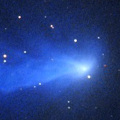
|
Now it is 15.9 mag (May 4, Toshihiko Ikemura, Hirohisa Sato). It will be fading slowly after this. It is observable in good condition in the Northern Hemisphere. In the Southern Hemisphere, it stays extremely low for a while.
Date(TT) R.A. (2000) Decl. Delta r Elong. m1 Best Time(A, h)
June 1 14 55.88 44 38.2 4.208 4.651 109 15.7 22:17 (180, 11)
June 8 14 51.14 43 26.7 4.301 4.703 107 15.8 21:45 (180, 12)
|
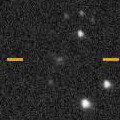
|
Now it is 16.6 mag (May 10, Mount John Observatory, Lake Tekapo). It stays 16 mag for a long time from 2019 to 2020. It is observable in excellent condition in the Southern Hemisphere. It is hardly observable in the Northern Hemisphere.
Date(TT) R.A. (2000) Decl. Delta r Elong. m1 Best Time(A, h)
June 1 11 13.38 -56 10.6 3.322 3.842 113 16.0 18:35 ( 0, 69)
June 8 11 5.78 -55 29.1 3.359 3.814 109 15.9 18:25 ( 10, 69)
|
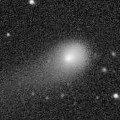
|
Now it is 16.1 mag (Apr. 27, Toshihiko Ikemura, Hirohisa Sato). It will be fading slowly after this. It will be getting lower gradually after this, and it will be unobservable in June.
Date(TT) R.A. (2000) Decl. Delta r Elong. m1 Best Time(A, h)
June 1 8 44.61 34 21.2 5.970 5.467 55 16.0 18:26 (151, 14)
June 8 8 45.66 33 35.3 6.108 5.508 49 16.1 18:25 (146, 11)
|
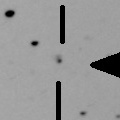
|
Asteroid, but it brightened rapidly. Now it is 16.9 mag (Mar. 27, iTelescope Observatory, Siding Spring). It is observable in excellent condition in the Southern Hemisphere. It is hardly observable in the Northern Hemisphere.
Date(TT) R.A. (2000) Decl. Delta r Elong. m1 Best Time(A, h)
June 1 22 18.55 -38 21.3 6.098 6.455 106 16.2 5:29 (320, 86)
June 8 22 14.37 -38 54.7 5.985 6.450 113 16.2 5:11 ( 0, 86)
|

|
Now it is 18.7 mag (May 7, Martin Masek). It will brighten rapidly up to 11.5 mag in autumn. In the Northern Hemisphere, it will be observable in excellent condition. In the Southern Hemisphere, it will be extremely low from autumn to winter.
Date(TT) R.A. (2000) Decl. Delta r Elong. m1 Best Time(A, h)
June 1 23 8.35 -19 26.7 1.485 1.791 89 16.8 5:29 (226, 69)
June 8 23 23.93 -17 33.4 1.390 1.748 91 16.3 5:32 (215, 69)
|
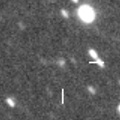
|
Now it is 17.8 mag (Mar. 31, iTelescope Observatory, Siding Spring). It will brighten up to 16.5 mag in June. It is observable in excellent condition in the Southern Hemisphere. It locates low in the Northern Hemisphere.
Date(TT) R.A. (2000) Decl. Delta r Elong. m1 Best Time(A, h)
June 1 17 18.51 -39 33.4 2.771 3.739 159 16.4 0:45 ( 0, 85)
June 8 16 58.23 -40 31.2 2.745 3.725 162 16.4 23:50 ( 0, 84)
|

|
It brightened up to 14 mag from autumn to winter in 2018. Now it is fading. It is observable in excellent condition in the Northern Hemisphere. It locates extremely low in the Southern Hemisphere.
Date(TT) R.A. (2000) Decl. Delta r Elong. m1 Best Time(A, h)
June 1 10 20.02 40 23.2 2.943 2.828 73 16.4 18:26 (172, 14)
June 8 10 27.88 38 4.8 3.061 2.871 69 16.5 18:25 (167, 16)
|

|
Now it is 16.8 mag (May 11, M. Suzuki, B. Lutkenhoner). It will brighten up to 16 mag from June to August, and it will be observable in excellent condition in the Northern Hemisphere. It is not observable in the Southern Hemisphere.
Date(TT) R.A. (2000) Decl. Delta r Elong. m1 Best Time(A, h)
June 1 0 17.32 59 4.8 2.156 1.834 58 16.8 5:29 (197, -8)
June 8 0 15.62 64 31.2 2.050 1.805 61 16.6 5:32 (191,-11)
|

|
Now it is 17.3 mag (May 4, Toshihiko Ikemura, Hirohisa Sato). It stays 16-17 mag for a long time until 2020. It is observable in good condition in the Northern Hemisphere. It is not observable at all in the Southern Hemisphere.
Date(TT) R.A. (2000) Decl. Delta r Elong. m1 Best Time(A, h)
June 1 10 52.82 66 48.4 8.726 8.464 71 16.8 18:26 (179,-12)
June 8 10 55.98 65 54.7 8.783 8.467 68 16.9 18:25 (176,-11)
|

|
It has not been observed yet in this apparition. It is expected to brighten up to 12 mag from August to September. It is observable in good condition in the Northern Hemisphere. It will be low around the high light in the Southern Hemisphere.
Date(TT) R.A. (2000) Decl. Delta r Elong. m1 Best Time(A, h)
June 1 0 28.41 -8 40.7 1.624 1.549 67 17.5 5:29 (240, 48)
June 8 0 46.56 -5 27.8 1.555 1.513 68 16.9 5:32 (233, 48)
|

|
It has not been observed yet in this apparition. It will be observable at 16 mag in good condition from summer to autumn. It locates somewhat low in the Southern Hemisphere.
Date(TT) R.A. (2000) Decl. Delta r Elong. m1 Best Time(A, h)
June 1 0 49.19 10 1.2 2.423 2.018 54 17.0 5:29 (229, 30)
June 8 1 3.21 11 42.6 2.365 2.015 57 16.9 5:32 (224, 32)
|
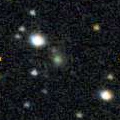
|
Now it is 16.6 mag (May 3, Toshihiko Ikemura, Hirohisa Sato). It is expected to be observable at 5-6 mag for a long time from 2022 to 2023. In the Northern Hemisphere, it is not observable at the highlight from 2022 summer to 2023 summer. In the Southern Hemisphere, it stays unobservable for a while. But it will be observable in good condition at the highlight.
Date(TT) R.A. (2000) Decl. Delta r Elong. m1 Best Time(A, h)
June 1 17 51.75 58 38.7 11.384 11.565 97 16.9 1:16 (180, -4)
June 8 17 47.35 58 43.1 11.334 11.519 97 16.9 0:44 (180, -4)
|

|
Now it is 16.8 mag (May 23, G. Hug). It will brighten up to 14 mag in winter. It stays observable for a long time in the Southern Hemisphere. It is observable only until early August in the Northern Hemisphere.
Date(TT) R.A. (2000) Decl. Delta r Elong. m1 Best Time(A, h)
June 1 16 52.38 -27 23.7 2.542 3.551 173 17.0 0:18 (180, 82)
June 8 16 39.64 -28 39.4 2.483 3.492 172 16.9 23:32 (180, 84)
|

|
Now it is 16.4 mag (May 7, Toshihiko Ikemura, Hirohisa Sato). It is observable at 17 mag in good condition in 2019. It locates somewhat low in the Northern Hemisphere.
Date(TT) R.A. (2000) Decl. Delta r Elong. m1 Best Time(A, h)
June 1 15 24.23 -15 29.5 2.914 3.893 162 16.9 22:45 (180, 71)
June 8 15 20.25 -15 25.1 2.959 3.902 154 17.0 22:14 (180, 70)
|

|
Now it is 17.7 mag (May 16, M. Masek). It will brighten up to 17 mag from June to July, and will be observable in good condition.
Date(TT) R.A. (2000) Decl. Delta r Elong. m1 Best Time(A, h)
June 1 19 32.37 -29 13.0 1.601 2.459 139 17.4 2:58 (180, 84)
June 8 19 3.85 -27 28.3 1.497 2.441 152 17.3 2:03 (180, 83)
|
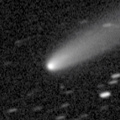
|
It brightened up to 13.2 mag from December to March (Dec. 30, Chris Wyatt). Now it is fading. It has already faded down to 16.6 mag (May 3, Toshihiko Ikemura, Hirohisa Sato). It will be fainter than 18 mag in June.
Date(TT) R.A. (2000) Decl. Delta r Elong. m1 Best Time(A, h)
June 1 11 47.97 -3 19.3 1.736 2.272 108 17.4 19:10 (180, 58)
June 8 11 55.24 -3 49.2 1.851 2.312 103 17.8 18:50 (180, 59)
|
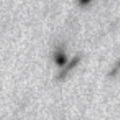
|
In the Southern Hemisphere, it is observable at 17.5 mag in good condition from spring to summer. In the Northern Hemisphere, it is not observable at all. It has not been observed since last September.
Date(TT) R.A. (2000) Decl. Delta r Elong. m1 Best Time(A, h)
June 1 16 47.58 -57 15.3 3.524 4.390 144 17.7 0:14 ( 0, 68)
June 8 16 40.77 -57 1.9 3.516 4.391 145 17.7 23:35 ( 0, 68)
|
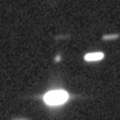
|
Now it is 17.5 mag (May 3, Toshihiko Ikemura, Hirohisa Sato). It is expected to brighten up to 13.5 mag in 2021, and it will be observable in good condition in the Southern Hemisphere. In the Northern Hemisphere, it is not observable at the highlight.
Date(TT) R.A. (2000) Decl. Delta r Elong. m1 Best Time(A, h)
June 1 13 42.89 7 39.6 6.557 7.235 128 17.7 21:04 (180, 47)
June 8 13 40.47 7 20.0 6.598 7.190 122 17.7 20:35 (180, 48)
|

|
It has not been observed yet in this apparition. Now it is fainter than 21.5 mag (Mar. 10, Erwin Schwab). It will be observable at 17.5 mag from June to August.
Date(TT) R.A. (2000) Decl. Delta r Elong. m1 Best Time(A, h)
June 1 18 58.81 -9 4.4 1.276 2.172 142 17.9 2:24 (180, 64)
June 8 18 57.74 -9 26.1 1.222 2.158 149 17.8 1:55 (180, 64)
|

|
Now it is 17.4 mag (May 7, Toshihiko Ikemura, Hirohisa Sato). It will brighten up to 17.5 mag from June to July.
Date(TT) R.A. (2000) Decl. Delta r Elong. m1 Best Time(A, h)
June 1 20 20.58 -23 13.6 1.793 2.545 127 17.8 3:45 (180, 78)
June 8 20 23.32 -24 39.1 1.750 2.562 134 17.8 3:20 (180, 80)
|

|
Now it is 17.7 mag (May 14, Catalina Sky Survey). It will be observable at 17.5 mag in excellent condition in the Northern Hemisphere. It locates somewhat low in the Southern Hemisphere.
Date(TT) R.A. (2000) Decl. Delta r Elong. m1 Best Time(A, h)
June 1 20 28.77 26 57.0 1.535 2.047 104 18.0 3:54 (180, 28)
June 8 19 55.59 29 4.2 1.421 2.048 113 17.9 2:54 (180, 26)
|
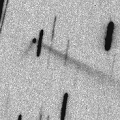
|
Main-belt asteroid. But it shows a straight tail like a comet. Now it is 18.1 mag (May 2, Toshihiko Ikemura, Hirohisa Sato). It stays observable in excellent condition until early summer.
Date(TT) R.A. (2000) Decl. Delta r Elong. m1 Best Time(A, h)
June 1 10 34.07 9 30.1 1.970 2.162 86 18.4 18:26 (170, 45)
June 8 10 43.07 9 33.8 2.039 2.147 81 18.4 18:25 (164, 44)
|
|
![]()
 C/2018 KJ3 ( Lemmon )
C/2018 KJ3 ( Lemmon ) (944) Hidalgo
(944) Hidalgo C/2019 J2 ( Palomar )
C/2019 J2 ( Palomar ) C/2010 U3 ( Boattini )
C/2010 U3 ( Boattini ) 168P/Hergenrother
168P/Hergenrother 261P/Larson
261P/Larson C/2017 K2 ( PanSTARRS )
C/2017 K2 ( PanSTARRS ) C/2019 K1 ( ATLAS )
C/2019 K1 ( ATLAS ) 74P/Smirnova-Chernykh
74P/Smirnova-Chernykh C/2019 J3 ( ATLAS )
C/2019 J3 ( ATLAS ) 60P/Tsuchinshan 2
60P/Tsuchinshan 2 186P/Garradd
186P/Garradd C/2019 F1 ( ATLAS-Africano )
C/2019 F1 ( ATLAS-Africano ) P/2012 K3 ( Gibbs )
P/2012 K3 ( Gibbs ) C/2019 J1 ( Lemmon )
C/2019 J1 ( Lemmon ) C/2019 JU6 ( ATLAS )
C/2019 JU6 ( ATLAS ) (6478) Gault
(6478) Gault![]()




























